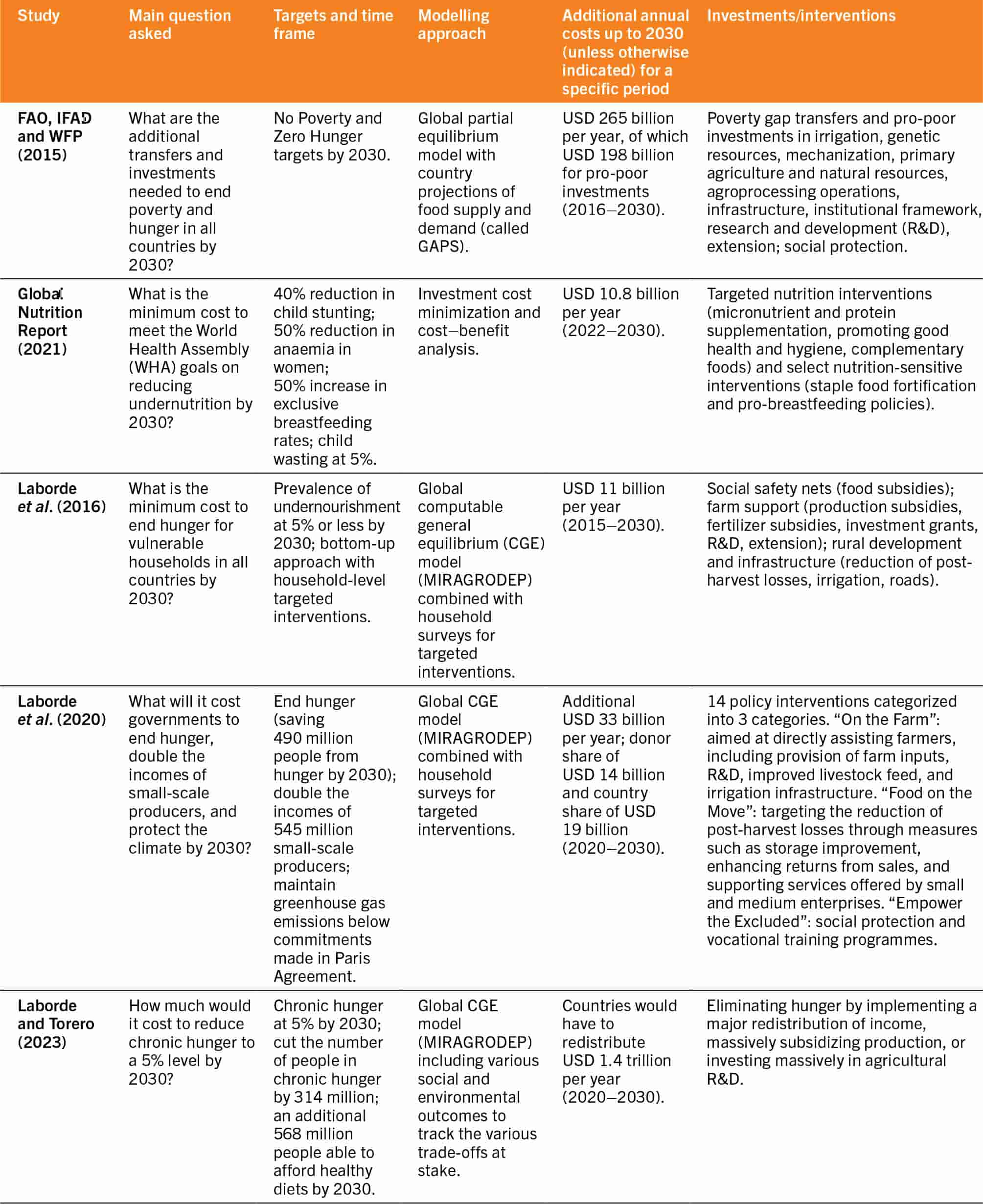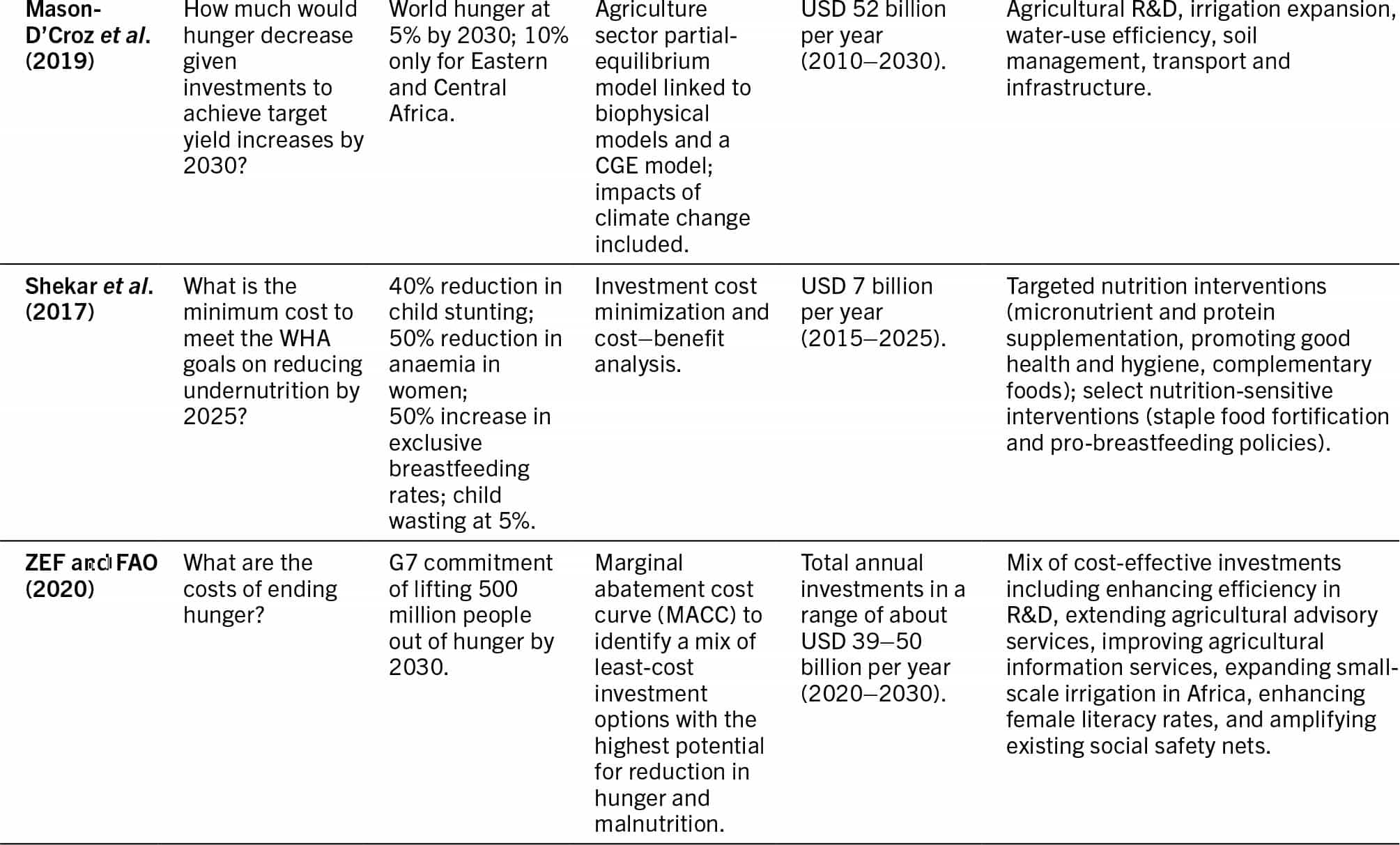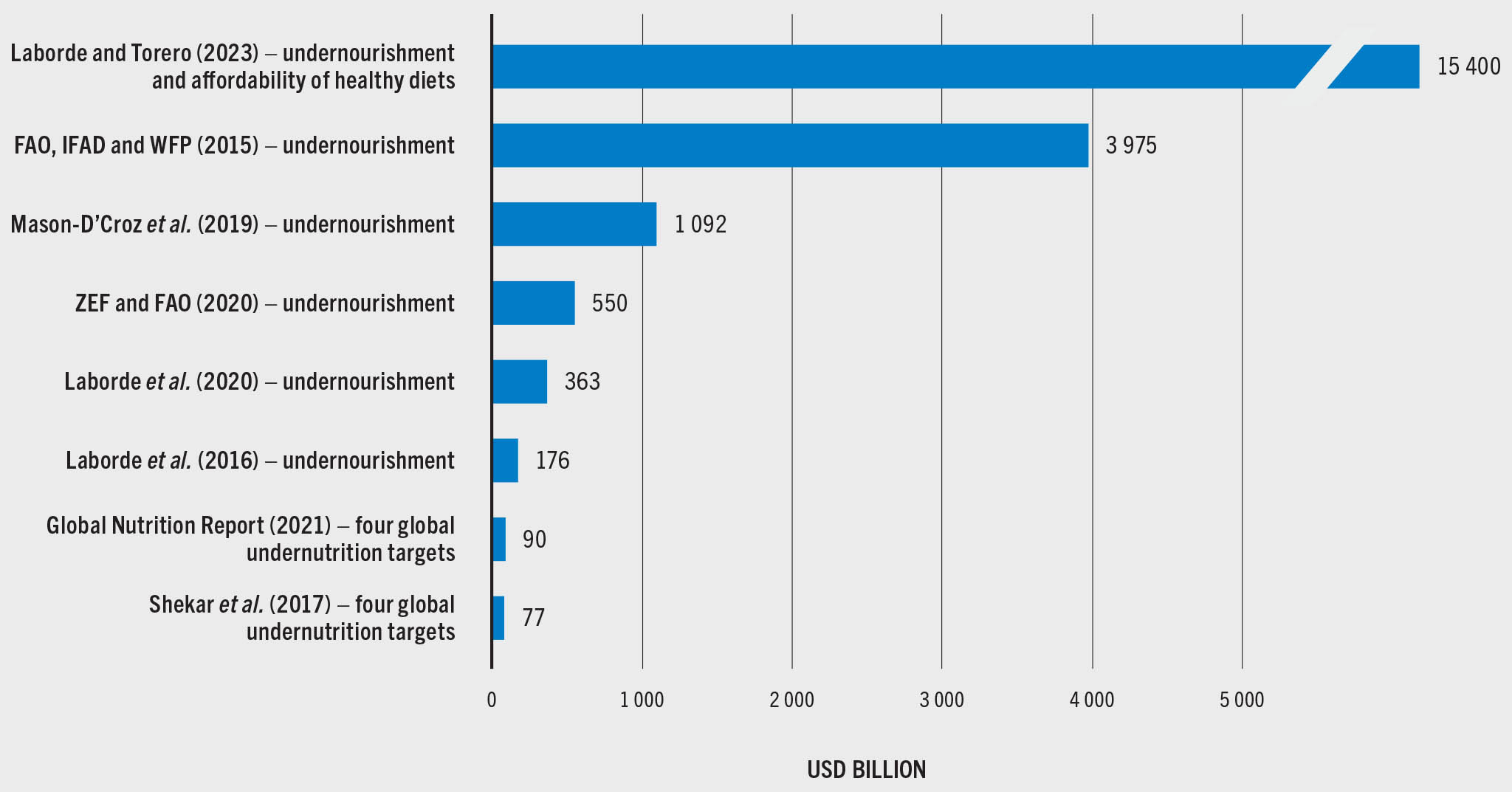All of the data on (domestic and external) public and private financing flows that are needed to apply the core and extended definitions of financing for food security and nutrition are not yet available. Consequently, it is not possible to gauge the financing gap that must be bridged globally to meet SDG Targets 2.1 and 2.2 by 2030.
Data development for a better accounting system is needed globally to understand how much financing is available to support internationally agreed upon goals such as SDG 2, using proper definitions to map financing flows to the development aspirations of the goals, including food security and nutrition goals. Filling the information deficit will require bold steps from the international community; otherwise, the likelihood of achieving development goals cannot be realistically estimated and projected.
Due to these existing data gaps to fully estimate how much additional financing is needed to end hunger, food insecurity and malnutrition, economic models are often used to estimate the necessary additional investments, mostly to reduce hunger, but also to address nutrition concerns, although to a lesser extent. This section reviews existing relevant studies, aiming to arrive at some indicative ranges of the cost of policies and interventions – that will require new financing – to end hunger, food insecurity and malnutrition by 2030. Cost estimates are partial, though, for several reasons explained below.
How much will ending hunger and malnutrition by 2030 cost at the minimum?
Several studies have estimated the global cost of additional investments to end hunger by 2030, whereas studies on ending malnutrition in its multiple forms are scarcer. These studies often rely on economic models such as global computable general equilibrium (CGE) models and global partial equilibrium models, marginal abatement cost curves (MACC), and investment cost minimization and cost–benefit analysis. The first two types of models have the advantage that they allow for first- and second-round effects of the additional investments for food security and nutrition on either specific sectors or the economy at large, or both, including through private investment and household consumption responses. For this reason, the review of studies relies a great deal on the literature that uses those models.
The studies provide different cost estimates for several reasons. To begin with, different global economic models or estimation techniques are used. There are also differences in the questions asked and objectives targeted, in the investment strategies or set of interventions considered to meet targets, and in the period of analysis. Most – but not all – analyses available use 2030 as the target year in line with the SDGs. Different measures to ascertain the end of hunger are also considered across studies; while most consider it to be achieved when the PoU is under 5 percent, others target almost or fully eliminating undernourishment. Most analyses use a base or business-as-usual scenario that begins in a past year and projects how many million people will still be undernourished in 2030. Subsequently, these exercises develop alternative scenarios whereby policies and interventions are stepped up to trigger changes to reduce hunger and malnutrition. The different analyses available may have a different first year for the base scenario, which affects the period of analysis and, hence, the cost estimates for the period from that first year to 2030 (or any other final year).
Because not all the relevant pillars of food security and not all the forms of malnutrition are systematically accounted for in existing studies, the cost estimates are only partial. Furthermore, because the quantitative methods differ across studies, the focus is mostly on the cost of new policies and interventions (which is the most comparable aspect across studies) and less on the resources mobilized for private investment and household food consumption in response to the policies and interventions, the magnitude of which is also important for food security and nutrition.
While these global analyses provide useful costings for different policies and interventions, it is not possible to know whether these policies and interventions can realistically be financed in practice to the extent estimated, not to mention the macroeconomic trade-offs of using one source of finance over another, and countries’ absorptive capacity for foreign resources and for fully executing newly available financing. These are important considerations at the country level as shown by a body of CGE modelling literature.v, 27 The global cost estimates here presented operate under the assumption that all the financing needed is available, which may not necessarily be the case for countries that have no easy access to grant aid or borrowing, or where there is no political feasibility to raise taxes. They also assume that countries that have access to such financing have full absorptive capacity, meaning that their economies can properly adjust to any local currency appreciation from foreign exchange inflows, which may also not be the case for some countries. The cost estimates must be taken with the assumption that the additional annual costs estimated by the studies for past years (i.e. before 2024) were never fully borne, because the exact investments and interventions whose costs are estimated were not necessarily implemented. Furthermore, these global analyses assume that groups of countries or regions implement the same policies and interventions in unison, which in practice would require a comprehensive global accord. The financial cost associated with enacting new legislation, which is a key tool for improving food security and nutrition and is inherently different from policies due to its capacity to create enforceable rights and obligations, is also not included in these studies.
Caveats aside, the reviewed studies provide an idea of the additional financing that could be needed to support policies and interventions for the world to be on track to meet SDG Targets 2.1 and 2.2. The main characteristics and findings of these studies are summarized in Table 17.
TABLE 17Overview of studies with cost estimates for ending hunger, food insecurity and malnutrition


The findings are that policies and interventions to get on track to meet SDG Targets 2.1 and 2.2 would require additional resources from now until 2030 ranging between USD 176 billion and USD 3.98 trillion to eradicate undernourishment, plus an additional USD 77–90 billion to meet selected global undernutrition targets. Estimates jump sharply to USD 15.4 trillion when adding the types of transformational policies that would require financing in order to increase the affordability of healthy diets for millions while still reducing undernourishment (Figure 29).w It is not possible to know exactly the extent to which these numbers are overestimating or underestimating the real financing gap. On the one hand, the baselines of these studies use PoU and malnutrition indicators that are outdated compared to those reported in Chapter 2 – because they have shown either progress or statistical improvement due to increased data availability, which may very well result in an overestimation of the real financing gap. On the other hand, since the existing studies have not comprehensively considered all the dimensions (or indicators) of food security and nutrition and the effects of the COVID-19 pandemic on all of them, among other shocks, there may also be an underestimation of the real financing gap. Nevertheless, the analyses reviewed prove useful to show that trillions of USD will be needed – in addition to existing financing – to finance alternative policy mixes so that meeting SDG Targets 2.1 and 2.2 can still be within reach.
FIGURE 29 Trillions of USD are estimated to be needed to finance investments for ending hunger and some forms of malnutrition, and TO INCREASE the affordability of healthy diets by 2030

Different interventions, same targets, different cost estimates
The various studies suggest that different policies and interventions can be used to meet the same SDG 2 target, but at different costs. Some case studies embrace the premise that hunger stems from a deficiency in purchasing power, resulting in lack of access to sufficient, safe and nutritious food. Consequently, achieving the goal of eliminating hunger (SDG 2) is contingent upon eliminating poverty (SDG 1) and upon broader economy-wide investments that boost GDP growth and people’s incomes. FAO, IFAD and WFP (2015)28 estimated that USD 265 billion per year are needed to eliminate hunger, of which USD 198 billion per year would be for targeted pro-poor private and public investments, especially in rural areas and agriculture.
In several studies, increasing agricultural productivity through new investments is seen as a channel to reduce hunger. It has been estimated – using a global economy-wide model – that investing an additional USD 52 billion annually between 2015 and 2030 to boost agricultural productivity in the face of climate change in LICs and MICs would fill the yield gaps and reduce the PoU to 10 percent in Eastern and Central African countries and to 5 percent in all other countries.29
Some studies focus on the most vulnerable households in all countries. A global economy-wide modelling study projects that the number of hungry people would decrease to 599 million from 2015 to 2030, primarily driven by economic growth, and to reduce this number to 310 million (or the PoU to 5 percent) by 2025, a policy mix would be needed. This includes a reallocation of public spending for countries to prioritize social safety nets supporting consumers through cash transfers and food stamps; farm support to increase production and farmers’ incomes; and investments in infrastructure, education, storage, market access and value chains. This policy mix results in an overall cost of USD 11 billion annually between 2015 and 2030 – of which USD 4 billion are expected to come from donor contributions and the remaining USD 7 billion from countries themselves. These measures are also projected to stimulate an additional USD 5 billion in private investment per year, on average.30
Another global economy-wide modelling study identifies 14 policy interventions that are clustered into three categories to, respectively: i) directly assist farmers, including through provision of farm inputs, research and development, improved livestock feed, and irrigation infrastructure; ii) reduce post-harvest losses through measures such as storage improvement, enhancing returns from sales, and supporting services offered by SMEs; and iii) empower excluded populations through social protection and vocational training programmes. It estimates that USD 33 billion per year would be needed between 2020 and 2030 to support these public interventions and reduce the PoU to 3 percent – of which USD 14 billion from donors and the remaining USD 19 billion from domestic resource mobilization. These public interventions would increase the profitability of primary and processed food sectors, attracting the private sector to invest USD 52 billion per year on average in such sectors.31
Using marginal cost curve analysis – a simpler approach that does not account for economy-wide effects – helped to estimate the additional costs associated with lifting people out of hunger through 24 interventions that have been proven to be the least-cost measures with significant potential for reducing hunger and malnutrition. These include a mix of enhancing efficiency in agricultural R&D, expanding agricultural extension services, improving agricultural information services, expanding small-scale irrigation in Africa, enhancing female literacy rates, and scaling up existing social safety nets. They would require an additional annual investment of about USD 39 to 50 billion to lift approximately 840 to 909 million people out of hunger by 2030.32
An investment cost minimization and cost–benefit approach helped estimate the minimum cost to meet four of the six World Health Assembly targets by 2025: i) reducing the number of stunted children under the age of five by 40 percent; ii) reducing the number of women at reproductive age with anaemia by 50 percent; iii) increasing the rate of exclusive breastfeeding in the first six months to 50 percent; and iv) reducing and maintaining child wasting at less than 5 percent. This study aligns with SDG Target 2.2 but does not fully cover it – as, for example, interventions to address child overweight are not included – and the study leaves out SDG Target 2.1. It estimates that an additional USD 7 billion per year is needed between 2015 and 2025 to achieve these four global nutrition targets through nutrition-specific investments in micronutrient supplementation, good infant and young child nutrition practices, and staple food fortification.33 To include additional costs for mitigating the impact of the COVID-19 pandemic, this cost estimate was updated to USD 10.8 billion per year, and the period of analysis was extended to 2030 (rather than 2025) from 2022.34
Cost estimates jump sharply when transformational policies and interventions to increase the affordability of healthy diets are factored in. Using a global economy-wide model, a study arrives at a much higher estimate of the cost of investments needed not only to reduce the PoU to 5 percent by 2030, but also to increase the affordability of healthy diets for 568 million people. Adding the latter target requires multiple policies and interventions to simultaneously transform agrifood systems and achieve SDG 2 targets. These interventions are tailored to increase calorie consumption while ensuring healthy diets, increasing the productivity and incomes of small producers, enabling the sustainable use of biodiversity and ecosystems, and addressing climate change. They are estimated to cost USD 1.4 trillion every year and include spending on social safety nets to ensure healthy diets for all; implementing school feeding programmes; repurposing farm subsidies; reforming consumer incentives; enhancing innovation, technology and knowledge for farmers; and reducing food loss and waste.35
It is important when considering the different cost estimates to keep all the aforementioned caveats in mind. Nonetheless, irrespective of what the exact amount of financing needed might be to make the necessary progress in all the indicators associated with SDG Targets 2.1 and 2.2, the financing gap is by no means negligible and the cost of not bridging it will be high, as is further explained in the next section.

